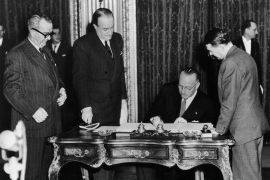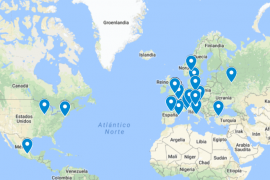[dropcap letter=”A”]
fter a century of humiliation and half a century of isolation, China is back in its “natural” place. That is, where it was for millennia: in the “centre” of the world, between heaven and earth—that is what China means in its own language. The current Chinese leaders—the Communist Party, understood not as a depositary and transmitter of ideology, but as an instrument of social hierarchy and political power—are “recovering” history. And they do it, as cannot be otherwise, from their geographical position. History always comes around again and geography is always there. China, like Russia a fundamentally terrestrial power, has considered its security by expanding its perimeter to borders that are easier to defend, and the further from the heart of the country, the better. An area that we can identify with “North China,” a huge plain—of an extension similar to that of Spain—between the basins of the Yellow and Yangtze rivers, which has marked its foreign policy for millennia.
That is why China led its expansion towards the north after the Mongol invasions, towards the Gobi desert; to the north-east with the incorporation of Manchuria, establishing its borders with Russia; to the south, until they reached the present borders with Vietnam, Laos and Myanmar—the old Burma; and to the east, with the annexations of Xinjiang—a Muslim-majority region with serious secessionist issues—and of Tibet, a former buffer state with India, and thus an essential element in China’s foreign policy. In both cases, the Chinese determination to maintain these territories is total and absolute, because they are of vital importance for their perception of security. And further east are the former Soviet republics of central Asia, now independent and with complex geopolitical and economic relations with China, Russia and Turkey.
ONE BELT, ONE ROAD
Hence the far-reaching importance of the Chinese One Belt, One Road or OBOR initiative, the new Silk Road. An initiative that should be framed within a new, far more aggressive foreign policy, oriented not at a wish to extend its political project of coexistence, but to expand its global geostrategic influence. And that corresponds to a great transformation, unprecedented in its history: China has assumed—as outlined in the resolutions of the recent 19th Congress of the Communist Party—that if it wants to be the great global power by the middle of this century, It must become a great terrestrial power, as it has been historically, but also an air, sea and space power. That is why we will have to get used to seeing Chinese warships in any sea or ocean on the planet, military bases on other continents, such as Africa, and a spectacular satellite deployment that is linked to the great strategic commitment to becoming a great technological power, based on human capital and a huge effort in education and training.
In this context, one of the most ambitious initiatives is OBOR. We are dealing with a contemporary reformulation of the historic Silk Road, a factor for what we know as the heart of the world that is Eurasia, which the great geopolitical thinkers have always discussed, beginning with the great Harold John Mackinder over a century ago. As a concept, the Silk Road was coined at the end of the 19th century to describe the extraordinary history of the intense trade between China and Europe over many centuries, and through great empires, such as the Persian, Ottoman or Byzantine Empires, and the great European powers, such as the Russia of the Tsars, the Austro-Hungarian Empire, the Holy Roman Empire, or the Spanish, French, Portuguese, Dutch or British monarchies.
Obviously, this is a magnificent example of the advantages of cooperative commercial exchange—denying avant la lettre the obsolete, rancid arguments that are favourable to trade protectionism and which we have to endure today. But in its present configuration, and as an initiative of the Chinese, it also constitutes an extraordinary sample of the sum of strategic projects based on transport infrastructures—both road, and above all rail—which by definition also represent an exchange of ideas and transmission of soft power involving mutually beneficial economic realities.
It is a project which from a terrestrial perspective consolidates the position of China in Central Asia, and from the maritime perspective, in the Indian Ocean. Considered that we are looking at an initial financing project of about 800 billion euros—three quarters of Spanish GDP—and reminiscent of the Marshall Plan for Western Europe, extraordinary for its time—the end of the Second World War. About sixty countries have joined this project—including the marine component—amongst which are Germany, France, the United Kingdom, Spain and Brazil, and more recently, Japan, initially reluctant for historical reasons and because of the pressure of the United States.
The territories covered by the new Silk Road involve one third of global international trade, 70% of the population, and 55% of global GDP. And we must add that it includes territories that hold three-quarters of the fossil energy reserves of the entire planet—and that is without considering the Arctic Ocean, the relevance of which will be crucial in the immediate future. But that is another issue.
All of this is obviously not at all insignificant from a geostrategic point of view, both for Central Asia and the Indian subcontinent, because Central Asia—the former republics of the old Soviet Union, now independent—has a natural and historical relationship with Russia, but also, for many reasons of a religious, linguistic and ethnic nature, with Turkey, and they possess a natural border with Iran, in other words with the ancient Persian Empire. And for the Indian subcontinent, because we are talking about the relationship, almost always tense and at times belligerent, with the other great Asian power—for now only regional, but increasingly relevant on a global scale—that is India, and its not always friendly relationship with the countries of South-east Asia.
This all goes hand-in-hand with the extraordinary strategic significance of the Strait of Malacca.
STRING OF PEARLS
The Strait of Malacca lies at the world’s equator and is the natural connection between the Indian Ocean and the Pacific. This author has long argued that it is the point where the centre of gravity of the planet is located, which brings us to other considerations that we will touch upon, although briefly.
 One of these is that even the usual terminology has become obsolete: we still talk about Japan, China or Indonesia as the Far East. A serious mistake of appreciation: they are at the centre and what is far or distant is us. Europe, from this perspective, is the new Far West from a geopolitical point of view. And another is that, for China, free passage through Malacca—between Singapore, Malaysia and Indonesia—is absolutely vital to the sustainability of its economic system and to continue to properly fuel its intense process of growth. Hence the Chinese effort, also military, to ensure its presence in the South China Sea, and to maintain friendly relations with the countries bordering the Strait, particularly with Singapore, which has a Chinese ethnic majority. But this also explains the maritime projection of OBOR, historically an absolute novelty.
One of these is that even the usual terminology has become obsolete: we still talk about Japan, China or Indonesia as the Far East. A serious mistake of appreciation: they are at the centre and what is far or distant is us. Europe, from this perspective, is the new Far West from a geopolitical point of view. And another is that, for China, free passage through Malacca—between Singapore, Malaysia and Indonesia—is absolutely vital to the sustainability of its economic system and to continue to properly fuel its intense process of growth. Hence the Chinese effort, also military, to ensure its presence in the South China Sea, and to maintain friendly relations with the countries bordering the Strait, particularly with Singapore, which has a Chinese ethnic majority. But this also explains the maritime projection of OBOR, historically an absolute novelty.
Thus, in the same way as India is building a strategic relationship with Iran to establish a maritime route as an alternative to the land passage through Pakistan, China has established a no less strategic relationship with Bangladesh, via a land-bridge through Myanmar—hence the permanent support from China for the regime there—bypassing the Malacca Strait for alternative access to the Indian Ocean. The Chinese strategy is thus commonly known as the String of Pearls, because the connecting dots of the new Maritime Silk Road draws something like it. And that does not only make economic and trade sense, but also military and strategic.
The starting point is at the most important harbour in Bangladesh, in the Ganges delta near Dhaka. From there, the next connecting dot is in Sri Lanka—the former Ceylon. The following one is located in Pakistan—a deep-rooted enemy of India, and a traditional ally of Beijing’s—where it is financing a huge port, which could also be a Chinese military base, at Gwadar. And from there, the next step is Djibouti, a guarantee of free passage through the Strait of Bab al-Mandeb, and thus a natural connection between the Indian Ocean and the Red Sea, and from there through the Suez Canal to the Mediterranean. And it is no coincidence that China has established an enormous military base with a capacity for about 6,000 troops, larger than the largest American military base in Africa, located in this tiny country. And the last point—for the time being—is the port of Piraeus, in Greece, literally bought up by Chinese capital. But this Chinese presence in Europe will go further. And it is no longer by chance you will see Chinese corvettes or frigates in several Mediterranean ports, including some Spanish ones.
THE NEW GREAT GAME
Obviously, this whole strategy is not viewed with indifference, but rather with anxiety and open hostility, by the United States and India, which are developing a joint strategic vision—which includes countries such as Japan or Australia—with an Indo-Pacific approach clearly opposed to the strategic interests of China: a new Great Game, a version of the strategy that the British implemented in their contention with the Russia of the Tsars for their dominance of the subcontinent bathed by the Indian Ocean. The Great Game is now between China and the other players in the region, including the United States.
Let us return to history and geography once more. As an empire at the centre of the world and a great terrestrial power, China has historically practiced two things. Firstly, policies aiming to subject the people, vassals and barbarians or enemies. Just recall the Qianlong Emperor’s letter replying to King George III in 1793, at his request of establishing diplomatic and trading relations between the two empires. It is a response of displicence, both disdainful and humiliating, which is typical of a civilization with thousands of years of history and that had, until the middle of the 19th century, been the most powerful nation on earth and the most populous. And which wishes to regain that economic and political power—demographically, it will soon be overtaken by India.
And, secondly, China needs access to the West, which by land was materialized historically via the Silk Road, connecting it with the East Indies, Central Asia, the Middle East and, finally, with Europe. But it also felt the need to project itself from the rest of the world through its open access to the Pacific and to the Indian Ocean. Like the United States, China wants to be a Twin-Ocean power. The United States achieved it in the Pacific, with its manifest destiny making west from the original Thirteen Colonies, and the war with Mexico, as well as the purchase of Alaska from the Russians—how they must regret it! They would now have the full command of the Bering Strait—and the incorporation of Hawaii just sixty years ago. But for its Atlantic projection, it was necessary to guarantee the control of the Caribbean, in a process that the Spaniards are well familiar with, with the loss of Cuba and Puerto Rico. Well, for China its “Caribbean” is the South China Sea, because its control allows free passage to the Pacific and, above all, access to the Indian Ocean, via Malacca.
Everything is thus complementary in a clear strategy by China to be and to guarantee its status as a great global power, in opposition to the United States. And the new Silk Routes are an essential part of that strategy, but not the only one. The first step in American imperialism was the so-called Monroe Doctrine. America for the Americans, which meant a rejection of European interference on the continent and, at the same time, a clear desire for hegemonic command over that same territory by the United States. And the next step was to become the great global power it is today.
ASIA FOR THE ASIANS
Similarly, China claims Asia for the Asians, that is, rejecting American interference on the continent, and above all, projecting a hegemonic command by China of that territory as a first step towards constituting itself as a great global power, in a strategic dispute with the United States. And if that contributes to weakening the Atlantic bond upon which is based the concept of the West, it will do so without flinching. Hence the vital importance for Europe of drawing its own strategy as a political project, perceived as such from abroad. But that is another question. The truth is that, in any case, the main scenario of confrontation is located around Malacca and goes far beyond the traditional scenarios of dispute: the Middle East and Europe. The approaching world scenario implies a momentous change of era.




















